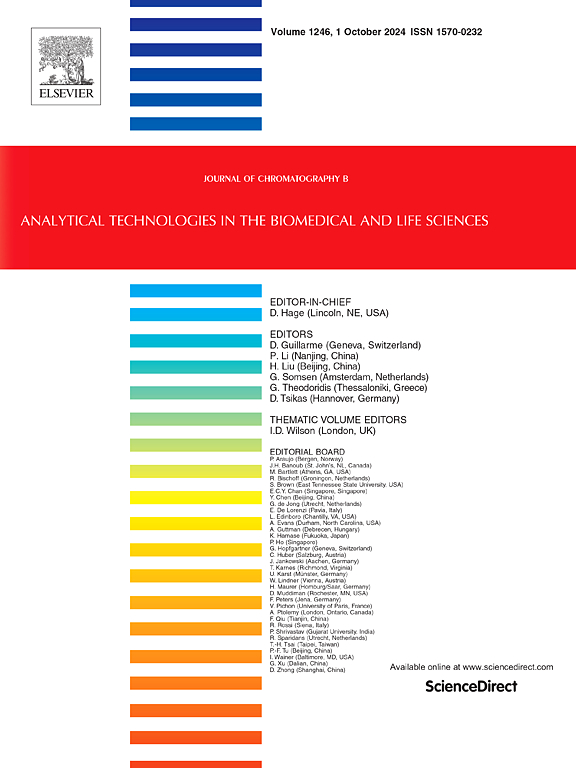Determination of tacrolimus in whole blood of pediatric liver transplant patients by UPLC–MS/MS: Informed its individualized dose
IF 2.8
3区 医学
Q2 BIOCHEMICAL RESEARCH METHODS
引用次数: 0
Abstract
Tacrolimus is a potent macrolide immunosuppressant widely used in pediatric liver transplant patients. However, its narrow therapeutic window and significant inter-individual pharmacokinetic differences result in a poor correlation between blood concentrations and administered doses. To support its individualized dose, a sensitive, fast and robust ultra-high performance liquid chromatography–tandem mass spectrometry (UPLC–MS/MS) method was developed to measure tacrolimus concentrations in whole blood of pediatric liver transplant patients. The method employed acetonitrile for protein precipitation, and sample separation was achieved using an Acquity UPLC CSH C18 column (2.1 × 50 mm, 1.7 μm) with gradient elution. The mobile phase consisted of ammonium solution–water (0.5:1000, v/v) and methanol. The method demonstrated good linearity within a concentration range of 0.20–50.00 ng/mL. The intra- and inter-day precisions of tacrolimus in whole blood were less than 13.5 %, with the accuracy ranged from −7.2 % to 13.0 %. Selectivity, carryover, matrix effects, recovery, dilution reliability, and stability all met the standards set by relevant guidelines. The established UPLC–MS/MS method was successfully applied to measure the concentration of tacrolimus in the whole blood of pediatric liver transplant patients and support its individualized dose. Under the rapid UPLC–MS/MS method, 25 (65.8 %) patients required a dose increase, 3 (7.9 %) patients needed a dose reduction, and 10 (26.3 %) patients maintained their original dosage without adjustment.
UPLC-MS /MS法测定儿童肝移植患者全血中他克莫司的含量:告知其个体化剂量
他克莫司是一种有效的大环内酯类免疫抑制剂,广泛应用于儿童肝移植患者。然而,其狭窄的治疗窗口和显著的个体间药代动力学差异导致血药浓度和给药剂量之间的相关性较差。为了支持他克莫司的个体化剂量,建立了一种灵敏、快速、可靠的超高效液相色谱-串联质谱(UPLC-MS /MS)方法来测定儿童肝移植患者全血中他克莫司的浓度。方法采用乙腈沉淀蛋白质,采用Acquity UPLC CSH C18色谱柱(2.1 × 50 mm, 1.7 μm)梯度洗脱,分离样品。流动相为铵溶液-水(0.5:1000,v/v)和甲醇。该方法在0.20 ~ 50.00 ng/mL的浓度范围内线性良好。他克莫司全血日内、日间精密度均小于13.5%,精密度范围为- 7.2% ~ 13.0%。选择性、携带性、基质效应、回收率、稀释度可靠性和稳定性均符合相关指南的标准。将建立的UPLC-MS /MS方法成功应用于儿童肝移植患者全血中他克莫司的浓度测定,并支持其个体化剂量。在快速UPLC-MS /MS方法下,25例(65.8%)患者需要增加剂量,3例(7.9%)患者需要减少剂量,10例(26.3%)患者保持原剂量而不进行调整。
本文章由计算机程序翻译,如有差异,请以英文原文为准。
求助全文
约1分钟内获得全文
求助全文
来源期刊

Journal of Chromatography B
医学-分析化学
CiteScore
5.60
自引率
3.30%
发文量
306
审稿时长
44 days
期刊介绍:
The Journal of Chromatography B publishes papers on developments in separation science relevant to biology and biomedical research including both fundamental advances and applications. Analytical techniques which may be considered include the various facets of chromatography, electrophoresis and related methods, affinity and immunoaffinity-based methodologies, hyphenated and other multi-dimensional techniques, and microanalytical approaches. The journal also considers articles reporting developments in sample preparation, detection techniques including mass spectrometry, and data handling and analysis.
Developments related to preparative separations for the isolation and purification of components of biological systems may be published, including chromatographic and electrophoretic methods, affinity separations, field flow fractionation and other preparative approaches.
Applications to the analysis of biological systems and samples will be considered when the analytical science contains a significant element of novelty, e.g. a new approach to the separation of a compound, novel combination of analytical techniques, or significantly improved analytical performance.
 求助内容:
求助内容: 应助结果提醒方式:
应助结果提醒方式:


